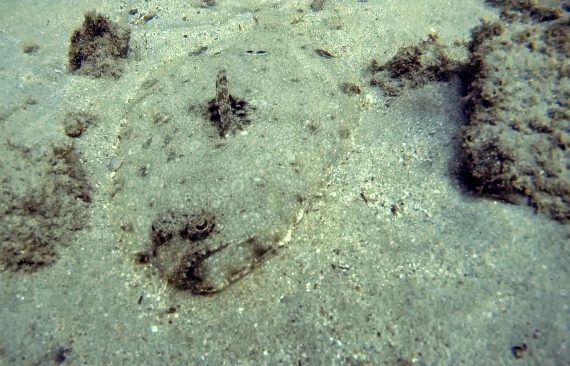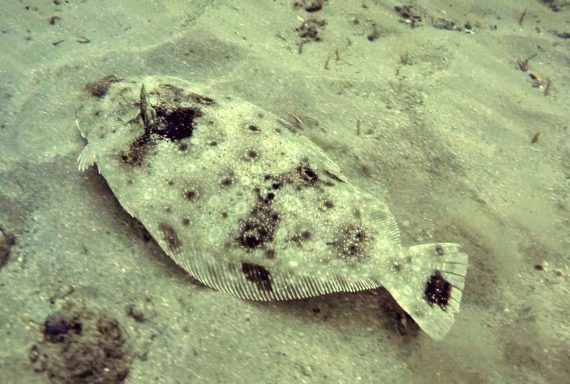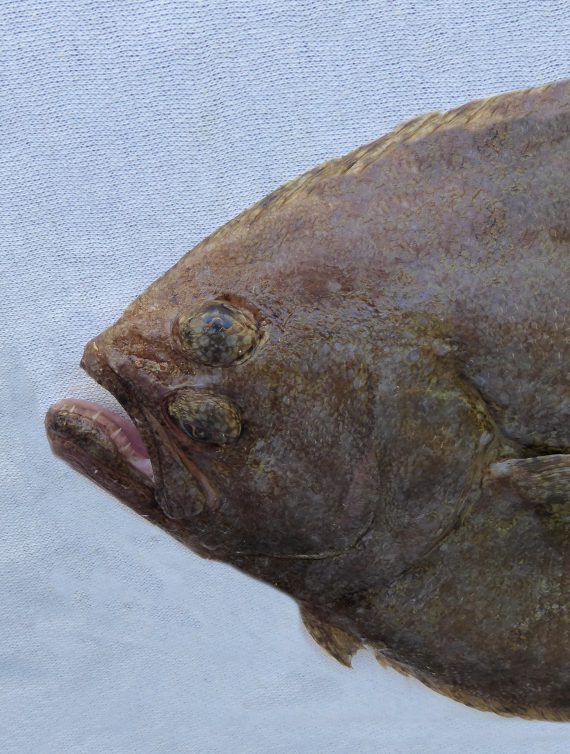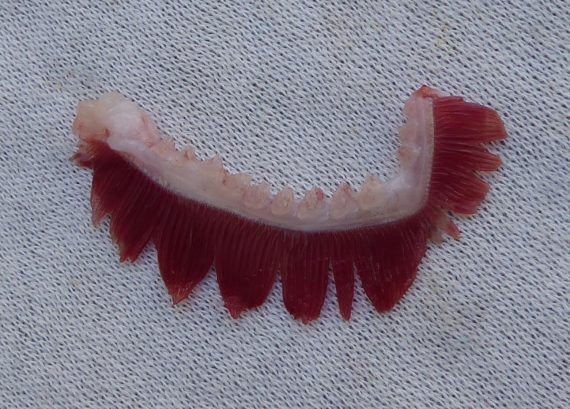Panamic Flounder, Cyclopsetta panámico

 Panamic Flounder, Cyclopsetta panamensis, Tentative Identification. Underwater photographs taken in Zihuantanejo Bay, Guerrero, March 2018. Photographs courtesy of Maude Jette, Dive Zihuantanejo, www.Divezihuantanejo.com. Identification to the Genus level courtesy of H.J. Walker, Jr., Scripps Institution of Oceanography, La Jolla, California. There are two resident Cyclopsettas in the Tropical Eastern Pacific Ocean. They are exceedingly difficult to separate and only possible with a hands-on examination of the fish. There is a 50% probability that this is a Toothed Flounder, Cyclopsetta querna.
Panamic Flounder, Cyclopsetta panamensis, Tentative Identification. Underwater photographs taken in Zihuantanejo Bay, Guerrero, March 2018. Photographs courtesy of Maude Jette, Dive Zihuantanejo, www.Divezihuantanejo.com. Identification to the Genus level courtesy of H.J. Walker, Jr., Scripps Institution of Oceanography, La Jolla, California. There are two resident Cyclopsettas in the Tropical Eastern Pacific Ocean. They are exceedingly difficult to separate and only possible with a hands-on examination of the fish. There is a 50% probability that this is a Toothed Flounder, Cyclopsetta querna.



 Panamic Flounder, Cyclopsetta panamensis, Left Eyed. Fish caught from coastal waters off Point Palmilla, Baja California Sur, November 2019. Length: 41.5 cm (16.3 inches). Note: the fish photographed above was caught on November 23, 2019 from 150-foot water in the same general location and same depth that I can caught a smaller one on October 24, 2019. Their identification is exceedingly difficult as there are two virtually identical members from the Cyclopsetta Genus found in Mexican waters, the fish pictured above, which I believe to be the Panamic Flounder, Cyclopsetta panamensis and the Toothed Flounder, Cyclopsetta querna. Differentiation is based on whether the eye-side scales are rough or smooth. At 41.5 cm (16.3 inches) in length the fish photographed immediately above establishes a new maximum length (extending my record) for the Panamic Flounder (I also have the world record for the Toothed Flounder). The skin “up grain” is definitely rough. I have also included a photograph of are the most unusual gill rakers found in this species. These fish lose their color immediately after being caught which make for a photographic challenge.
Panamic Flounder, Cyclopsetta panamensis, Left Eyed. Fish caught from coastal waters off Point Palmilla, Baja California Sur, November 2019. Length: 41.5 cm (16.3 inches). Note: the fish photographed above was caught on November 23, 2019 from 150-foot water in the same general location and same depth that I can caught a smaller one on October 24, 2019. Their identification is exceedingly difficult as there are two virtually identical members from the Cyclopsetta Genus found in Mexican waters, the fish pictured above, which I believe to be the Panamic Flounder, Cyclopsetta panamensis and the Toothed Flounder, Cyclopsetta querna. Differentiation is based on whether the eye-side scales are rough or smooth. At 41.5 cm (16.3 inches) in length the fish photographed immediately above establishes a new maximum length (extending my record) for the Panamic Flounder (I also have the world record for the Toothed Flounder). The skin “up grain” is definitely rough. I have also included a photograph of are the most unusual gill rakers found in this species. These fish lose their color immediately after being caught which make for a photographic challenge.
The Panamic Flounder, Cyclopsetta panámico, is a member of the Sand Flounder or Paralichthyidae Family, that is also known as God’s Flounder and in Mexico as lenguado panámico. Globally, there are five members of the genus Cyclopsetta, of which four are found in Mexican waters, two in the Atlantic and two in the Pacific Ocean.
The Panamic Flounder is a flatfish that has an elongated oval body with a depth that is 39% to 43% of standard length. Their eye side is dark brown with faint pale white spots on the head and body. Their anal and dorsal fins have several dark blotches. Their caudal fin has a large dark spot near its tip. Their blind side is off-white. They have a small rounded head with a short snout and a large mouth that ends behind the rear edge of their eyes. Their large eyes are predominately on the left side, elevated, parallel, and separated by a flat space. They have one row of immovable teeth on both jaws and a pair of canines at the front of their top jaw. Their anal fin has 70 to 78 rays; their caudal fin is short and pointed and has a wide base; and their dorsal fin has 90 to 99 rays and originates before the top eye. They have 8 to 10 very short, fat, and most unusually-shaped gill rakers on their lower arch (see photograph above). They are covered with small rough scales on their eye side and with small smooth scales on their blind side and their lateral line is straight and originates just behind their eyes and extends to their caudal base.
The Panamic Flounder is a demersal species that is found over and within sandy and muddy bottoms at depths up to 129 m (395 feet). They are known to enter brackish waters. They reach a maximum of 41.5 cm (16.3 inches), based on a fish that I caught in November 2019. They are opportunistic and well-camouflaged ambush predators that lie in wait half submerged on the ocean floor. They prey on small fish and a wide variety of crustaceans. The Panamic Flounder is poorly studied with very limited information available about their lifestyle and behavioral patterns including specific details on age, growth, longevity, movement patterns, diet, habitat use, and reproduction.
The Panamic Flounder is a resident of all waters of the Pacific Ocean with the exception that they are absent from Magdalena Bay, Baja California Sur northward along the central and northwest coast of Baja and in the northern 20% of the Sea of Cortez.
The Panamic Flounder can be confused with the California Halibut, Paralichthys californicus (arched lateral line; doubly concave caudal fin; 25 to 32 gill rakers), the Cortez Halibut, Paralichthys aestuarius (arched lateral line; 24 to 31 gill rakers), the Dappled Flounder, Paralichthys woolmani (arched lateral line; 16 to 20 gill rakers), and the Toothed Flounder, Cyclopsetta querna (smooth scales on eye side).
From a conservation perspective the Panamic Flounder is currently considered to be of Least Concern with stable, widely distributed populations. They fairly rare and therefore of limited interest to most. They are however a quality food fish when available.